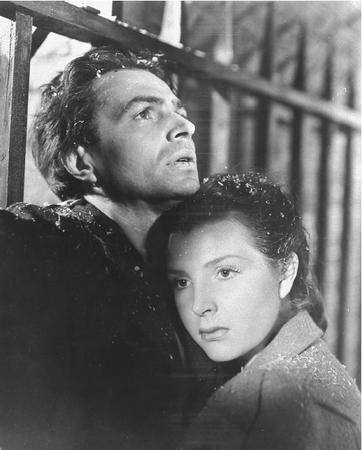
Black, darkly-spacious, savory noir-goodness. If you enjoy such sweet specialties, then Carol Reed's Odd Man Out is for you. I'm not quite certain if this is "the most exciting picture ever made" (although it very-well may have been for 1947), but I know that it's probably one of the greatest less known film-noir masterpieces of all-time (Reed's The Third Man is similar). L. Maltin, in bold, black and white, CAPS: "SEE THIS ONE!"; which, surprisingly-enough, is a bit rare, even for his "personal tastes" (the inclusion of "odd" isn't typically one of his interest-points as I've noticed, but this film certainly bars no subtraction for tastes).

James Mason, being one of my favorite actors of all-time, always seems to leave me breathless with each viewing of his works; squishy-eyeball'd and rovingly wanting more, and in this performance, he stars as Johnny McQueen (first reaction: Steve McQueen), the "chief" of a gang, or an "organized group" of thieves, whom leads his men into an IRA bank for an obvious robbery of "goods" that will help McQueen's band of running-mates continue to gain strength, and to build their organization towards a dominant Power House. Unfortunately, however, the heist goes awry when McQueen is injured in a shooting in front of the bank when attempting to make their getaway (he, the last one left behind, suddenly appears to begin hallucinating before being able to stumble his way to the getaway vehicle), and is eventually left behind by his fellow theivery-pigeons.
As Carol Reed so beautifully photographs the following steps into the film, we see McQueen encounter a wide variety of characters and problems on this [sometimes] surrealistic odyssey through the streets of "a city of Northern Ireland." What one review wrote: "What nearly all the characters have in common is their lack of compassion for the wounded man. Ironically, the most sympathetic character in the story is Johnny [McQueen] himself. The elevation of this criminal to near-sainthood stretches the bounds of credibility a bit, yet through his eyes, one finds compassion for the less enlightened people who confront him at every turn. Among the self-centered characters who take him in is Lukey (Newton), an eccentric, alcoholic artist obsessed with the idea of capturing the soul on canvas. This makes Johnny, as he looks death in the eye, Lukey’s dream subject, one he doesn’t want to lose at any cost. (His portraits look eerily similar to the paintings showcased weekly on Rod Serling’s macabre TV series of the late '60's/early '70's, Night Gallery.) Although it's hard to accept his insensitivity toward Johnny’s suffering, it's Newton’s complex performance itself that made me feel compassion for Lukey in the end. The cinematography/art direction in this film is gorgeous and melancholy, with plenty of contrast, sharp detail, and interesting camera angles and effects, and the original score is unusually haunting. Together, they set the perfect mood for a poignant ending." And poignantly-gorgeous it is, which, admittedly-so, slightly surprised me.
My favorite scene (which is stunning, and doesn't last long enough) from this film is when Johnny begins hallucinating, where he sees framed paintings rise from the floor and float off of the walls. See it Here.
As Carol Reed so beautifully photographs the following steps into the film, we see McQueen encounter a wide variety of characters and problems on this [sometimes] surrealistic odyssey through the streets of "a city of Northern Ireland." What one review wrote: "What nearly all the characters have in common is their lack of compassion for the wounded man. Ironically, the most sympathetic character in the story is Johnny [McQueen] himself. The elevation of this criminal to near-sainthood stretches the bounds of credibility a bit, yet through his eyes, one finds compassion for the less enlightened people who confront him at every turn. Among the self-centered characters who take him in is Lukey (Newton), an eccentric, alcoholic artist obsessed with the idea of capturing the soul on canvas. This makes Johnny, as he looks death in the eye, Lukey’s dream subject, one he doesn’t want to lose at any cost. (His portraits look eerily similar to the paintings showcased weekly on Rod Serling’s macabre TV series of the late '60's/early '70's, Night Gallery.) Although it's hard to accept his insensitivity toward Johnny’s suffering, it's Newton’s complex performance itself that made me feel compassion for Lukey in the end. The cinematography/art direction in this film is gorgeous and melancholy, with plenty of contrast, sharp detail, and interesting camera angles and effects, and the original score is unusually haunting. Together, they set the perfect mood for a poignant ending." And poignantly-gorgeous it is, which, admittedly-so, slightly surprised me.
My favorite scene (which is stunning, and doesn't last long enough) from this film is when Johnny begins hallucinating, where he sees framed paintings rise from the floor and float off of the walls. See it Here.


No comments:
Post a Comment